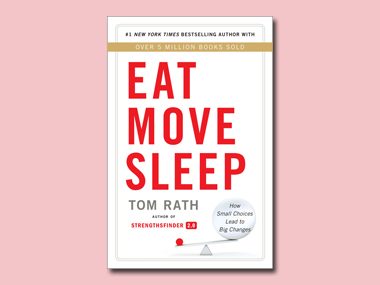
Save the cake for your birthday.
“While celebrating birthdays, anniversaries, holidays, and other milestones is healthy, using them as an excuse for eating sugar and carbs is not,“ Rath writes. If you’re trying to cut back on sweets, redefine what a special occasion means to you—every day is going to be someone’s birthday, right? Enjoy the cake when it’s special. If you’re eating out, ask for a bowl of berries instead of a dessert menu.

Stick to unsweetened coffee, tea, and water.
About half of Americans consume a sugary beverage daily, Rath writes, but even one or two sweetened drinks a day can boost your risk of type 2 diabetes by more than 25 percent as well as raise your odds for certain cancers. Artificially sweetened drinks aren’t the answer; some research suggests they can prime your taste buds to crave other sweet foods. While some people should avoid caffeine, the latest research on coffee is that it may help you live longer, decrease the risk of depression, and slow cognitive decline. Tea, with a host of powerful antioxidants, may lower inflammation, prevent cancer, and protect your skin.

Beware of “anchor orders” at restaurants.
The first person to order sets the tone for the whole table, Rath says. An “anchor order“ of fried calamari gives everyone else more license to indulge; a sensible salad puts pressure on everyone to pick similarly healthy dishes. Avoid this psychological trap by deciding on something nutritious before others start announcing their choices. Also interesting: The more people you eat with, the more food you eat. One companion will up your intake by 35 percent; more than four will boost it by a whopping 75 percent.

Stop buying junk food “for friends.”
It’s easy to buy cookies or chips and rationalize they’re “for company,” but Rath says that’s essentially saying that “a food is not healthy enough for me, but still okay to give to loved ones or friends.” Most of us want to eat healthy options and assume (often incorrectly) that others prefer junkier snacks. Change this trend by serving nutritionally sound choices to your guests or at a potluck.

Try “product placement” strategies at home.
Marketers, Rath writes, have known for decades that you buy what you see first, like grocery items that are shelved at eye level. Use this science in your own home by keeping splurge foods out of sight in your fridge, freezer, and pantry. “Foods sitting on tables and counters are even more critical for improving your choices,” says Rath. “When you see food every time you walk by, it gives you permission to graze.” Try snacking on pistachios and apples instead of candy and crackers.

Don’t eat meals family style.
Research shows women eat about 10 percent more and men 29 percent more when they eat out of large shared plates instead from a pre-served portion. “Large serving plates moving around the table create peer pressure,” Rath writes. “Everyone feels obligated to take a sample of each item to avoid offending the chef.” Having the additional food close by on the table also makes it easy to reach mindlessly for seconds (or thirds). A better idea: Leave platters in the kitchen and let people serve themselves before they sit down.

Snack on just a handful.
We eat more than we intend to when we eat mindlessly; a Harvard study found that people consume an extra 167 calories per hour when they eat while watching TV. Guard against these instincts by grabbing a handful-sized portion of your favorite munchies to bring to the couch, or to your desk, instead of the entire bag or box. This ensures you won’t get “so engrossed in what you’re doing that you forget to stop eating,” says Rath.

Make every meal last at least 20 minutes.
“Nothing good comes from racing through meals,” Rath writes. The hormones in your digestive system need about 20 minutes to cue to your brain that you’re full, so if you shovel in your meal in 10 minutes, you could wind up overeating. Eating too rapidly can raise your risk of obesity, diabetes, and heartburn. Chew your food properly and take time to chat with your family and friends between bites; it should take you at least 20 minutes.

More tips on how to start eating healthy:
For more tricks on portion control, squeezing in fitness, and getting better sleep, get Tom Rath’s new book Eat Move Sleep.